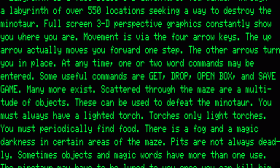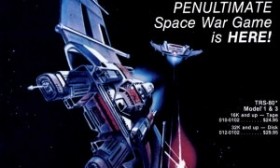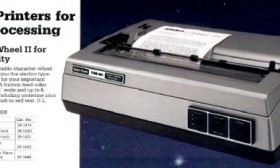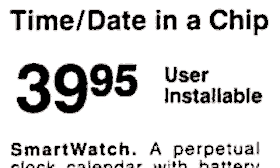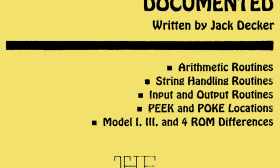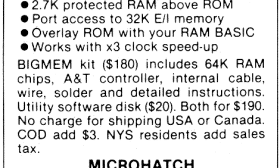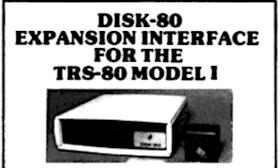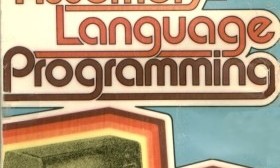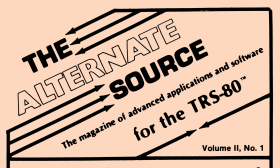Labyrinth was the second game in the “Continuum Series,” a set of 3-D adventures sold by Med Systems Software. It was preceded in the series by Deathmaze 5000 and followed by Asylum and Asylum II. Like most of their games, Med Systems also sold tape and disk versions of Labyrinth for the Apple II.
Labyrinth was in many ways a continuation of Deathmaze 5000. Once again, the player is trapped in a gigantic maze which contains numerous dangers. This time, the primary goal is to defeat the Minotaur, a half-bull, half-man creature from Greek mythology.
(Read more...)
The “New Products” section in the TRS-80 magazine 80 Microcomputing was a listing of new product releases, described this way:
The New Products section is intended to inform our readers of new products on the market. All information in the section is taken from product releases sent by manufacturers.
But starting in 1982, every April issue included several gag products mixed in with the usual announcements. Here are just a few of those “April Fool’s” new products.
(Read more...)
Starfighter, written by Sparky Starks, falls somewhere between an arcade game and a simulation. Far more than a shoot-em-up game, the incredibly detailed scenario in Starfighter lends itself to a game that can be played for hours. Although a unique game, Starfighter has some similarities to Star Raiders, a 1979 game for the Atari 800 that was written by Doug Neubauer.
Sparky Starks later wrote a version of Starfighter for the Atari 400/800 using the name Destiny: The Cruiser. A new name was required because Adventure International had already sold the rights to the name Starfighter to be used by the movie The Last Starfighter.
The goal in Starfighter is to pilot a spacecraft, the SC-78503 Starfighter, and destroy hostile enemy spacecraft. From a description in an Adventure International catalog:
(Read more...)
The Daisy Wheel Printer II (catalog number 26-1158), more commonly known as the Daisy Wheel II, DW II, or DWP II, was the highest quality TRS-80 printer that Radio Shack sold. It was introduced in 1980 for a price of $1,960.00, although that was later raised to $1,995.00. Radio Shack featured the Daisy Wheel II in their catalog from 1981 to 1984 as their “best high-speed, formed-character printer.”
The Daisy Wheel II was a replacement for the rarely remembered Daisy Wheel Printer I (catalog number 26-1157), which was described by Ed Juge this way:
(Read more...)
The SmartWatch was a single-chip clock/calendar add-on that could be used by many computers, including the TRS-80 Model I, III, and 4. The SmartWatch chip, a Dallas Semiconductor DS1216E, worked by replacing a 28-pin ROM and plugging the chip into its socket. Installation varied depending on the computer, but the general steps were simple:
(Read more...)
Understanding how to use TRS-80 ROM routines was very important for any TRS-80 Model I or III programmer, and there were many books written about that subject. TRS-80 ROM Routines Documented by Jack Decker was considered to be one of the best. Jack Decker wrote many articles for The Alternate Source, including a series named “TRS-80 ROM Routines Documented,” which served as the basis for this book.
The bulk of TRS-80 ROM Routines Documented is composed of five chapters detailing various portion of the TRS-80 ROM:
(Read more...)
BIGMEM was a modification for the TRS-80 Model I which increased available memory. It was introduced by Microhatch in early 1982 for $180.00, but the price was reduced to $169.00 by late 1983. Microhatch also sold a utility disk (with print spooler) for $20.00 which could be bundled with BIGMEM. For any user unwilling to perform the modification, Microhatch would install BIGMEM for $199.00.
Much like the Holmes Internal Memory, BIGMEM replaced the 16K RAM chips inside the Model I with higher-capacity 64K chips. This avoided the reliability problems of the external memory in an Expansion Interface and also worked better with most speed-up kits.
(Read more...)
The Disk-80 was an alternative to the Radio Shack Expansion Interface that was sold by Micromint Inc. It was designed by Steve Ciarcia and was featured in his “Ciarcia’s Circuit Cellar” column in the March 1981 issue of Byte.
The Disk-80 was sold in several configurations:
(Read more...)
At one time in the TRS-80 world, the name William Barden was linked to assembly language programming. This book was one of the main reasons why.
TRS-80 Assembly Language Programming, along with
Programming the Z80 by Rodney Zaks, helped introduce a whole generation of TRS-80 programmers to assembly language.
(Read more...)
The Alternate Source, also known as The Alternate Source Programmer’s Journal or TAS, was a well-remembered and very technical TRS-80 publication. Later billed as “The magazine of advanced applications and software for the TRS-80,” the first issue was published by Joni Kosloski and Charley Butler in January 1980. It was published once every two months for a total of six issues a year.
The concept behind The Alternate Source originated in October 1979. The Alternate Source was also the name of a company run by Butler and Kosloski that sold TRS-80 books and software. TASMON (The Alternate Source Monitor) was one of their more popular software packages. They also sold The Alternate Source in book form, with each year’s issues collected into one volume.
(Read more...)
